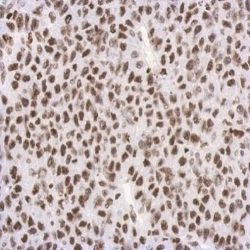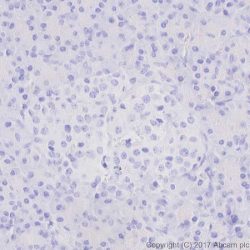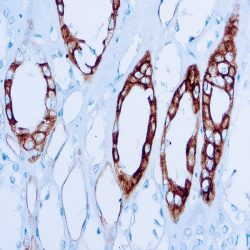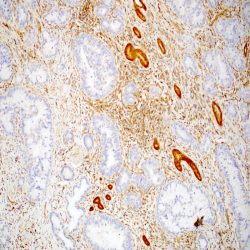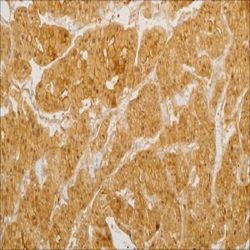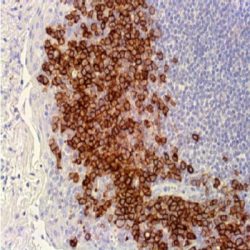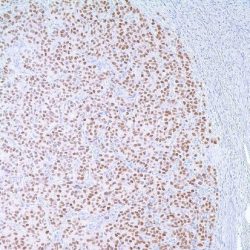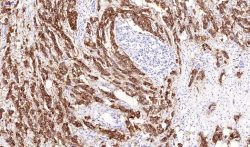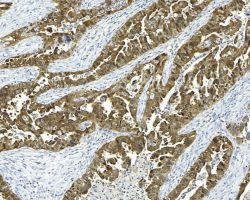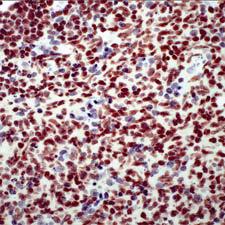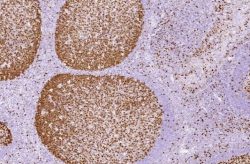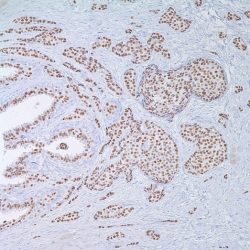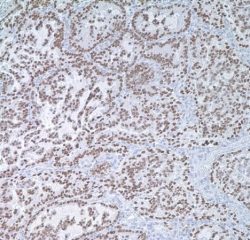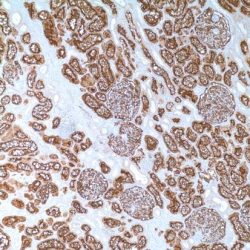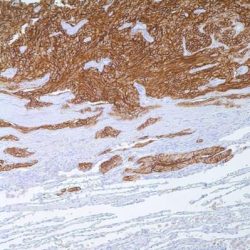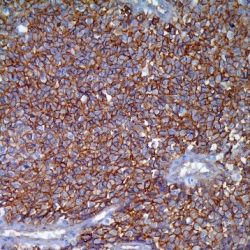Category: monoclonal
Showing 281–300 of 478 results
فیلتر ها-
آنتی بادیهای ایمونوهیستوشیمی
آنتی بادی – H3K27me3 (Lys27) (clone C36B11)
Rated 0 out of 5Name: Rabbit Anti-Human H3K27me3 (Lys27) Monoclonal Antibody (Clone C36B11)
Description and aplications: The nucleosome, which consists of four core histone proteins (H2A, H2B, H3 and H4), is the main component of chromatin. Originally thought to function as a static scaffold for DNA packaging, histones have subsequently been shown to be dynamic proteins, undergoing multiple types of posttranslational modifications, including acetylation, phosphorylation, methylation, and ubiquitination. Histone methylation is a fundamental determinant for
the formation of active and inactive regions of the genome and is crucial for their proper programming during embryonic development. Arginine methylation of histones H3 (Arg2, 17, 26) and H4 (Arg3) promotes transcriptional activation and is mediated by a family of arginine methyltransferase (PRMT)-like proteins, including the coactivators PRMT1 and CARM1(PRMT4). In contrast, a more diverse set of lysine methyltransferase-type histones has been identified, among which all but one contains a conserved catalytic SET domain, and that was originally identified in the Zeste and Trithorax regulatory proteins of the fly Drosophila Su (var) 3-9. Lysine methylation occurs primarily at histones H3 (Lys4, 9, 27, 36, 79) and H4 (Lys20) and has been implicated in both transcriptional activation and gene silencing. Additionally, methylation of these lysine residues coordinates the recruitment of chromatinmodifyinenzymes containing methyl lysine binding modules, either as chromodomains (HP1, PRC1), PHD fingers (BPTF, ING2), Tudor domains (53BP1) and WD-40 domains (WDR5). Finally, the discovery of histone demethylases such as PADI4, LSD1, JMJD1, JMJD2 and JHDM1 has demonstrated that methylation is a reversible epigenetic marker. NF1 mutations and inactivation of CDKN2A are found
in most malignant peripheral nerve sheath tumors (TMVNP), where inactivation of CDKN2A is an early event during their development, occurring in the course of progression from conventional to atypical neurofibroma. Furthermore, inactivation of the polycomb repressive complex 2 (PRC2) resulting from mutually exclusive mutations of its SUZ12 or
EED1 portions has recently been identified in 70-90% of TMVNPs. In this regard, inactivation of PRC2 leads to loss of trimethylation at histone H3 lysine 27 (H3K27me3).Composition: Anti-human H3K27me3 (Lys27) rabbit polyclonal antibody obtained from ascitic fluid and prepared in 10mM PBS, pH 7.4, with 0.2% BSA and 0.09% sodium azide.
Immunogen: Synthetic peptide corresponding to the terminal amino acids of human histone 3 in which Lys27 is trimethylated.
-
آنتی بادیهای ایمونوهیستوشیمی
آنتی بادی PRAME 1 (EPR20330)
Rated 0 out of 5Name: Rabbit Anti-Human PRAME 1 Monoclonal Antibody (Clone EPR20330)
Description and aplications: The PReferentially expressed Antigen in MElanoma (PRAME), or LB33-E antigen, is part of the family of melanoma nuclear proteins recognized by cytolytic T lymphocytes and is encoded by a gene of the same
name (PRAME) located on chromosomal region 22q11.22. The PRAME protein has been characterized as a dominant inhibitor of the retinoic acid receptor, thus participating in the blockade of cell proliferation, differentiation or apoptosis induced by retinoic acid through the RARA, RARB and RARG receptors. Thus, overexpression of PRAME in tumor cells confers a survival advantage over normal cells. In melanomas, PRAME inhibition restores retinoic acid signaling an reinstates the sensitivity of tumor cells to the antiproliferative effects of this molecule.Composition: Anti-human PRAME 1 rabbit monoclonal antibody obtained from ascitic and prepared in 10mM PBS, pH 7.4, with 0.2% BSA and 0.09% sodium azide.
Immunogen: N/A
-
آنتی بادیهای ایمونوهیستوشیمی
آنتی بادی Renal cell carcinoma marker (PN-15)
Rated 0 out of 5Name: Mouse anti- Human Renal cell carcinoma marker (PN-15) Monoclonal Antibody
Description and aplications:This antibody detects the membrane glycoprotein gp200. In a normal kidney, gp200 is located along the brush border of the contoured and straight segments of the proximal tubule, as well as focally along the luminal surface of Bowman’s capsule, contiguous with the exit of the proximal tubule. Gp200 is also located on the luminal surface of the mammary ducts and lobes and the tubular epithelium of the epididymis, in the cytoplasm of parathyroid and parenchymal cells, and focally within the colloid of thyroid follicles.
Composition: Anti-human renal cell carcinoma marker (PN-15) mouse monoclonal antibody purified and prepared in 10mM PBS, pH 7.4, with 0.2% BSA and 0.09% sodium azide.
Immunogen: Microsomal fraction of human renal cortical tissue homogenate.
-
آنتی بادیهای ایمونوهیستوشیمی
آنتی بادی SMAD4/Dpc4 (B8)
Rated 0 out of 5Name: Mouse Anti-Human SMAD4/Dpc4 Monoclonal Antibody (Clone B8)
Description and applications: The Mothers Against Decapentaplegic homolog 4(SMAD4) protein, also known as MADH4, MANrelatedprotein 4, MAD, pancreatic carcinoma deletion factor 4 or DPC4, is linked to the SMAD4 suppressor gene, which consists of 11 exons, and is located in the genomic region 18q21.1. This gene shows allelic or biallelic loss in 50% of pancreatic carcinomas
Composition: Anti-human SMAD4/Dpc4 mouse monoclonal antibody obtained from ascitic fluid and prepared in 10mM PBS, pH 7.4, with 0.2% BSA and 0.09% sodium azide
Immunogen: N/A -
آنتی بادیهای ایمونوهیستوشیمی
آنتی بادی Parvalbumin (EP300)
Rated 0 out of 5NAME: Rabitt anti-Parvalbumin Antibody (Clon EP300)
Description and applications: Parvalbumin is a protein with wide calcium-ionbinding affinity and thus intervenes in its cytosolic homeostasis. The PVALB gene, which encodes the production of this protein, is located in the chromosome region 22q12.3 and shows structural and functional similarities with the one of the Calmodulin and Troponin C, whose coding genes constitute a superfamily.
Composition: anti-human Parvalbumin rabbit monoclonal antibody purified from serum and prepared in 10mM PBS, pH 7.4, with 0.2% BSA and 0.09% sodium azide
-
آنتی بادیهای ایمونوهیستوشیمی
آنتی بادی CD38 (CD38/4328)
Rated 0 out of 5Name: CD38 Antibody Clone CD38/4328
Description and applications: CD38 is a single chain type II integral transmembrane protein, which is
highly expressed on thymocytes. It is also present on activated T cells and terminally differentiated B cells
(plasma cells). Other reactive cells include NK cells, monocytes, macrophages, and dendritic cells. CD38
may be detected on cells from multiple myeloma, ALL (B and T) and some AML. It is, however, not found on most mature resting peripheral lymphocytes. CD38 functions as a multicatalytic ectoenzyme serving as
ADP-ribosyl cyclase, cyclic ADP-ribose hydrolase and possibly NAD+ glycohydrolase or as a cell surface receptor.Composition: Anti-human CD38 mouse monoclonal antibody purified from serum and prepared in 10mM PBS, pH 7.4, with 0.2% BSA and 0.09% sodium azide.
Immunogen: Recombinant full-length human CD38 protein.
-
آنتی بادیهای ایمونوهیستوشیمی
آنتی بادی ER (Estrogen Receptor) کلون ZR2 برند Patho Sage
Rated 0 out of 5Specification:
Recognizes a protein of 67kDa, which is identified as estrogen receptor (ER) alpha. The ER gene consists of more than 140kb of genomic DNA divided into 8 exons, being translated into a protein with six functionally discrete domains, labeled A through F. This antibody strongly stains the nucleus of epithelial cells in breast carcinomas. The ER is an important regulator of growth and differentiation in the mammary gland. Presence of ER in breast tumors indicates an increased likelihood of response to antiestrogen (e.g. tamoxifen) therapy.
Immunogen:
A synthetic peptide corresponding to residues on the C-terminus of human ER-α
Presentation:
Rabbit monoclonal antibody. Tissue culture supernatant with 0.2% BSA and 15mM sodium azide
-
آنتی بادیهای ایمونوهیستوشیمی
آنتی بادی C-erbB-2 (HER2) کلون MXR011 برند Patho Sage
Rated 0 out of 5Specification:
C-erbB2 (also called Her-2/neu, ERBB2 or neu) is a transmembrane receptor tyrosine kinase. HER-2 is considered as the target oncogene driving the amplification, so that its activation will causes malignant transformation and increases the malignant potential (cell proliferation, invasiveness etc.) of the cells. Amplification of C-erbB2 gene invariably leads to overexpression of its protein product. Over-expressed C-erbB protein disturbs the HER-receptor family signaling networks, i.e. signaling mediated via EGFR receptor.
Presentation:
Supernatant contains 15mM sodium Azide
-
آنتی بادیهای ایمونوهیستوشیمی
آنتی بادی P504S (AMACR) کلون 13H4 برند Patho Sage
Rated 0 out of 5Specification:
AMACR (P504S) is an essential enzyme in the β-oxidation of branched-chain fatty acids. Recently, AMACR (P504S) was identified through cDNA library subtraction and microarrays in malignant prostate tissues. High expression of AMACR (P504S) protein is found in prostatic adenocarcinoma but not in benign prostatic tissue by immunohistochemical staining in paraffin-embedded tissues. The expression of AMACR (P504S) is also detected in two premalignant lesions of the prostate: high-grade prostatic intraepithelial neoplasia (PIN) and atypical adenomatous hyperplasia. Using AMACR (P504S) as a positive marker along with basal cell staining (34 βE12 or P63) as a negative marker could help to confirm the diagnosis of small focus of prostate carcinoma on needle biopsy.
Immunogen:
Full length human recombinant AMACR protein
Presentation:
Culture Supernatant with 0.05% Azide
-
آنتی بادیهای ایمونوهیستوشیمی
آنتی بادی P16-INK4 کلون MX007 برند Patho Sage
Rated 0 out of 5Specification:
As one of the cyclin-dependent kinase inhibitors that inhibit cyclin-dependent kinases 4 and 6, p16 INK4A is encoded by tumor suppressor gene CDKN2A. The tumor suppressor p16 INK4A plays an important role in cell cycle regulation. Increased expression of the p16 gene, which is seen as organisms age, reduces the proliferation of stem cells. This reduction in the division and production of stem cells protects against cancer while increasing the risks associated with cellular senescence. Mutations in the p16 gene associated with loss or over expression of the protein are associated with increased risk of a wide range of cancers and cancer precursor lesions. The Immunohistochemical identification of p16 is particularly relevant in uterine cervical lesions: Development of dysplasia is closely related to human papilloma virus (HPV) infection.
Presentation:
Tissue culture supernatant containing 15mM sodium azide
-
آنتی بادیهای ایمونوهیستوشیمی
آنتی بادی TDT کلون MX010 برند Patho Sage
Rated 0 out of 5Specification:
TDT is a DNA polymerase that catalyses the addition of deoxynucleotides to free 3’OH groups on polydeoxynucleotide chains. TDT is present in the nucleoli of normal T and B lymphocyte precursors and the neoplastic equivalent. Positive cells are most abundant in normal thymus, especially in the cortex, with little or no labelling of the medulla. A few cells in the normal bone marrow corresponding to hematopoietic precursor cells, also express TDT. TDT is a valuable marker in the identification of immature T and B Lymphocyte precursors and acute leukaemia’s. It is expressed at high level in T cell and pre-B cell acute lymphoblastic leukaemia’s and lymphomas. B-cell ALL and mature (or peripheral) B and T cell malignancies are TDT-negative. TDT may also be expressed in some cases of acute myeloid leukaemia.
Presentation:
Tissue culture supernatant containing 15mM sodium azide.
-
آنتی بادیهای ایمونوهیستوشیمی
آنتی بادی PAX5 کلون MX017 برند Patho Sage
Rated 0 out of 5Specification:
The PAX-5 gene is essential for B-cell differentiation. There are at least four isoforms, of which PAX-5a has been most studied. PAX-5 encodes the 50 kDa B-cell specific activator protein, BSAP. PAX-5 is expressed by pro-, pre-and mature Bcells, but is downregulated during terminal differentiation of plasma cells. PAX-5 influences the expression of other B-cell specific genes, including CD19 and CD20 and CD79a, preceding the expression of CD20. PAX-5 is silenced at the plasma cell stage under the influence of B-lymphocyte-induced maturation protein-1 (PRDM1). PAX-5 is expressed during mouse embryogenesis within the developing brain in a way that is temporarily and spatially tightly condoled. PAX-5 deficient mice show deformation of the mid-brain. Expression in human embryogenesis occurs in the mesoencephalon and spinal cord.
Presentation:
Tissue culture supernatant containing 15mM sodium azide
-
آنتی بادیهای ایمونوهیستوشیمی
آنتی بادی KI67 کلون MXR002 برند Patho Sage
Rated 0 out of 5Specification:
The Ki-67 protein is a nuclear protein doublet, 345-395 kDa, playing a pivotal role in maintaining cell proliferation. In diagnostic histopathology and cell biology, the antibody has proven valuable for the demonstration of the Ki-67 antigen in normal and neoplastic cells, for example in soft-tissue sarcoma, prostatic adenocarcinoma, and breast carcinoma. The Ki-67 has been confirmed as a very powerful single prognostic factor for overall survival, with highly proliferative cases showing a much poorer outcome than tumors with low proliferation. In breast cancer, the proliferative index measured by Ki-67 immunoreactivity has both prognostic and predictive value.
Presentation:
1ml Ki-67 tissue culture supernatant contains 15mM Azide
-
آنتی بادیهای ایمونوهیستوشیمی
آنتی بادی PR (Progesterone Receptor) کلون MRX008 برند Patho Sage
Rated 0 out of 5Specification:
Progesterone Receptor is a protein with 946 amino acids, is a ligand-activated transcription factor member of the steroid receptor super family of nuclear receptors. Progesterone Receptor is predominantly expressed in female sex steroid responsive tissues such as the mammary gland, uterus and ovary. But Progesterone Receptor is also found in other tissues such as endocrine cells of the Langerhans islets. Progesterone Receptor exists in two isoforms, Progesterone Receptor alpha and Progesterone Receptor-β, transcribed from two promoters by a single gene. The two Progesterone Receptor isoforms are identical except that Progesterone Receptor-alpha lacks 164 amino acids contained at the N-terminal end of the Progesterone Receptor-β. Progesterone Receptor alpha is the major isoform in the uterine stroma, and Progesterone Receptor-β is the predominant isoform in the endometrial glands.
Presentation:
Supernatant contain 15mM Sodium Azide
-
آنتی بادیهای ایمونوهیستوشیمی
آنتی بادی TTF1 کلون SPT24 برند Patho Sage
Rated 0 out of 5Specification:
TTF-1 (Thyroid transcription factor-1) is a member of the NKx2 family of homeodomain transcription factors. It is expressed in epithelial cells of the thyroid gland and the lung.1 Nuclei from liver, stomach, pancreas, small intestine, colon, kidney, breast, skin, testes, pituitary, prostate, and adrenal glands are unreactive. TTF-1 is detected in primary lung adenocarcinomas and small cell carcinomas and is absent in colon and breast carcinomas. Staining with TTF-1 antibody is useful for distinguishing between tumors of lung and non-lung origin.
Immunogen:
Prokaryotic recombinant protein corresponding to a 123 amino acid fragment of the N-terminal region of the TTF-1 molecule.
Presentation:
It is a liquid tissue culture supernatant containing 15mM sodium azide as a preservative.
-
آنتی بادیهای ایمونوهیستوشیمی
آنتی بادی CD10 کلون 56C6 برند Patho Sage
Rated 0 out of 5Specification:
Common acute lymphoblastic leukemia antigen (CALLA / CD10) is a useful marker for the characterization of childhood leukemia and B cell lymphomas. This antibody reacts with antigen of lymphoblastic, Burkitt’s, and follicular lymphomas; and chronic myelocytic leukemia. Also, Anti-CD10 detects the antigen of glomerular epithelial cells and the brush border of the proximal tubules; this characteristic may be helpful in interpreting renal ontogenesis in conjunction with other markers. Other non-lymphoid cells that are reactive with CD10 are breast myoepithelial cells, bile canaliculi, neutrophils and small population of bone marrow cells, fetal small intestine epithelium, and normal fibroblasts. Recently Anti-CD10 has been used to classify follicular thyroid lesions.
Presentation:
Anti-CD10 is a mouse monoclonal antibody in tissue culture supernatant containing 15mM sodium azide
-
آنتی بادیهای ایمونوهیستوشیمی
آنتی بادی Chromogranin A کلون LK2H10 برند Patho Sage
Rated 0 out of 5Specification:
Chromogranin A is present in neuroendocrine cells throughout the body, including the neuroendocrine cells of the large and small intestine, adrenal medulla and pancreatic islets. It is an excellent marker for carcinoid tumors, pheochromocytomas, paragangliomas, and other neuroendocrine tumors. Co-expression of chromogranin A and neuron specific enolase (NSE) is common in neuroendocrine neoplasms. Reportedly, co-expression of certain keratins and chromogranin indicates neuroendocrine lineage. The presence of strong anti-chromogranin staining and absence of anti-keratin staining should raise the possibility of paraganglioma. The co-expression of chromogranin and NSE is typical of neuroendocrine neoplasms. Most pituitary adenomas and prolactinomas readily express chromogranin.
Immunogen:
Human pheochromocytoma
Presentation:
Bioreactor Concentrate with 0.05% Azide
-
آنتی بادیهای ایمونوهیستوشیمی
آنتی بادی CD56 (NCAM-1) کلون 123C3.D5 برند Patho Sage
Rated 0 out of 5Specification:
This MAb reacts with an extracellular domain (close to transmembrane) of CD56/NCAM. Three isoforms of neural cell adhesion molecule (NCAM) are produced by differential splicing of the RNA transcript from a single gene. The 135kDa isoform is the basic molecule, which is glycosylated or sialylated to produce the mature species. CD56/NCAM is reported to express on most neuroectodermal derived cell lines, tissues, and neoplasms such as retinoblastoma, medullblastoma, astrocytoma, and neuroblastoma. It is also expressed on some mesodermally derived tumors such as rhabdomyosarcoma and also on natural killer cells.
Immunogen:
Membrane preparation of a small cell lung carcinoma
Presentation:
Bioreactor Concentrate with 0.05% Azide
-
آنتی بادیهای ایمونوهیستوشیمی
آنتی بادی Synaptophysin کلون EP158 برند Patho Sage
Rated 0 out of 5Specification:
Anti-synaptophysin reacts with neuroendocrine cells of human adrenal medulla, carotid body, skin, pituitary, thyroid, lung, pancreas, and gastrointestinal mucosa. This antibody identifies normal neuroendocrine cells and neuroendocrine neoplasms. Diffuse, finely granular, cytoplasmic staining is observed, which probably correlates with the distribution of the antigen within neurosecretory vesicles. The expression of synaptophysin is independent of the presence of NSE or other neuroendocrine markers. Anti-synaptophysin is an independent, broad-range marker of neural and neuroendocrine differentiation.
Presentation:
Tris Buffer, pH 7.3-7.7, with 1% BSA and <0.1% Sodium Azide
-
آنتی بادیهای ایمونوهیستوشیمی
آنتی بادی CD99 کلون EPR3097Y برند Patho Sage
Rated 0 out of 5Specification:
MIC-2 (CD99) antigen is present on the cell membrane of Ewing’s Sarcoma and primitive peripheral neuroectodermal tumors (PNET). It is also present on some bone marrow, lymph nodes spleen, cortical thymocytes, granulosa cells of the ovary, most beta cells, CNS ependymal cells, Sertoli’s cells of the testis and endothelial cells. MIC-2 (CD99) has also been identified in lymphoblastic lymphoma, rhabdomyosarcoma, mesenchymal chondrosarcoma, and thymoma. CD99 is expressed in most pancreatic endocrine tumors and loss of CD99 expression is associated with poor prognosis in these tumors.
Presentation:
Anti-CD99 is a rabbit monoclonal from tissue culture supernatant diluted in tris buffered saline, pH 7.3-7.7, with protein base, and preserved with sodium azide.

